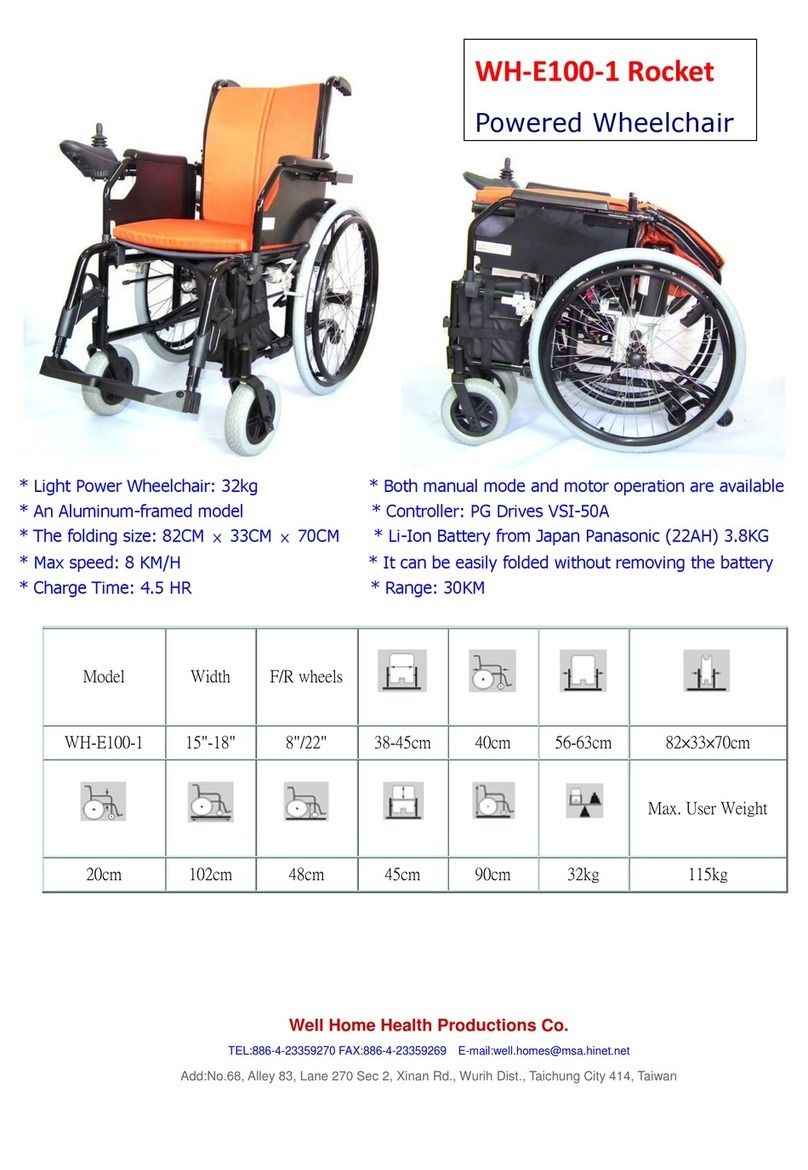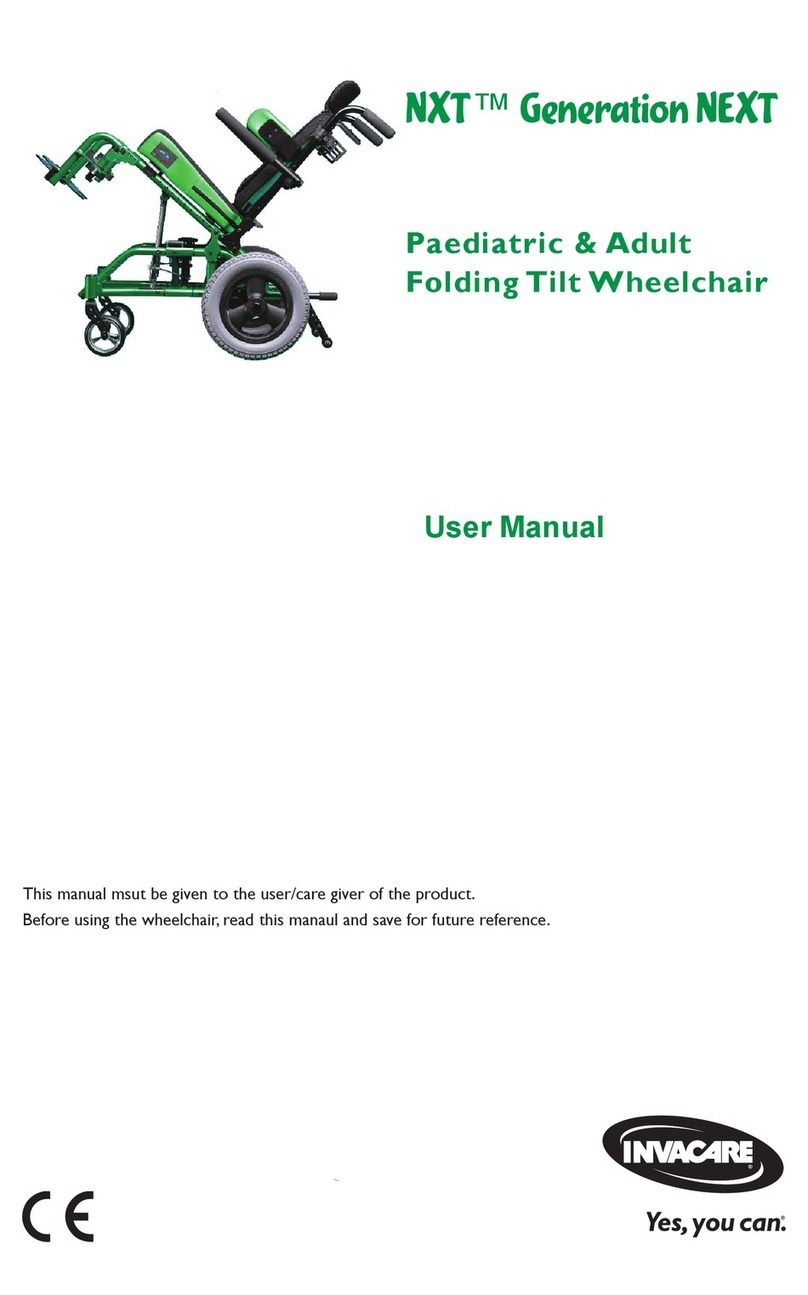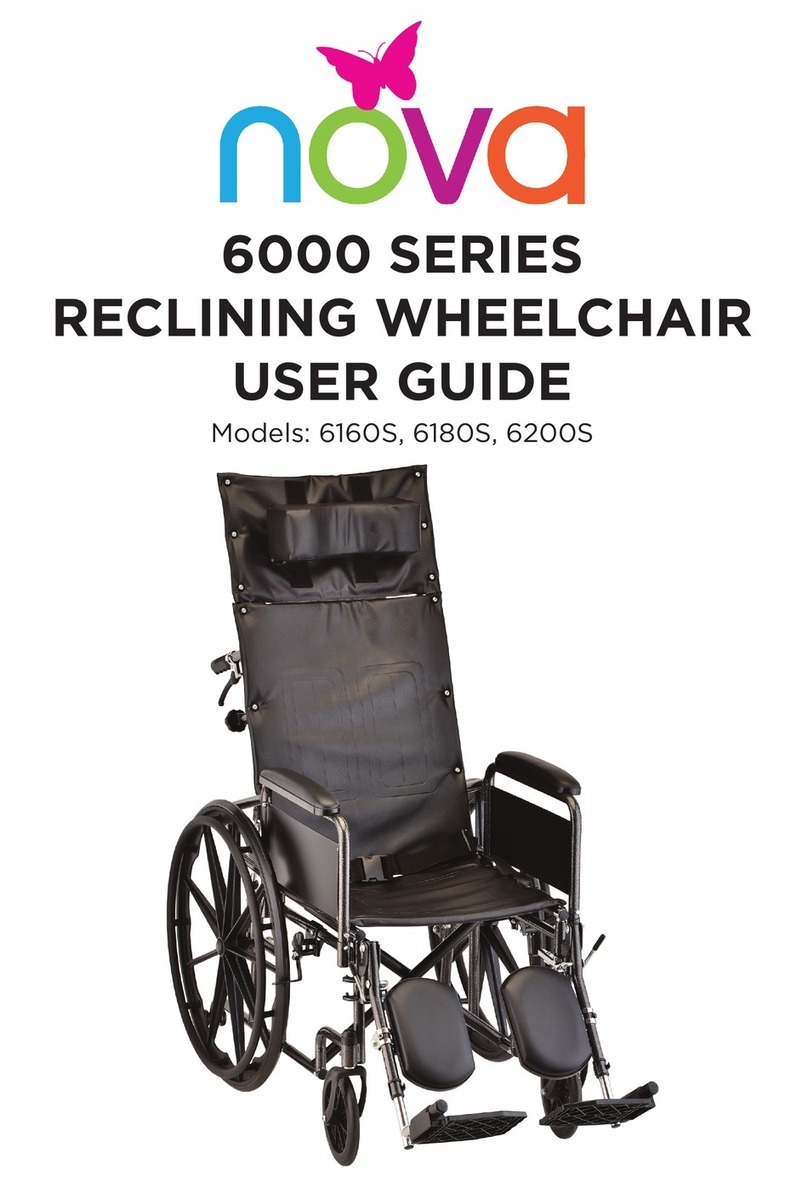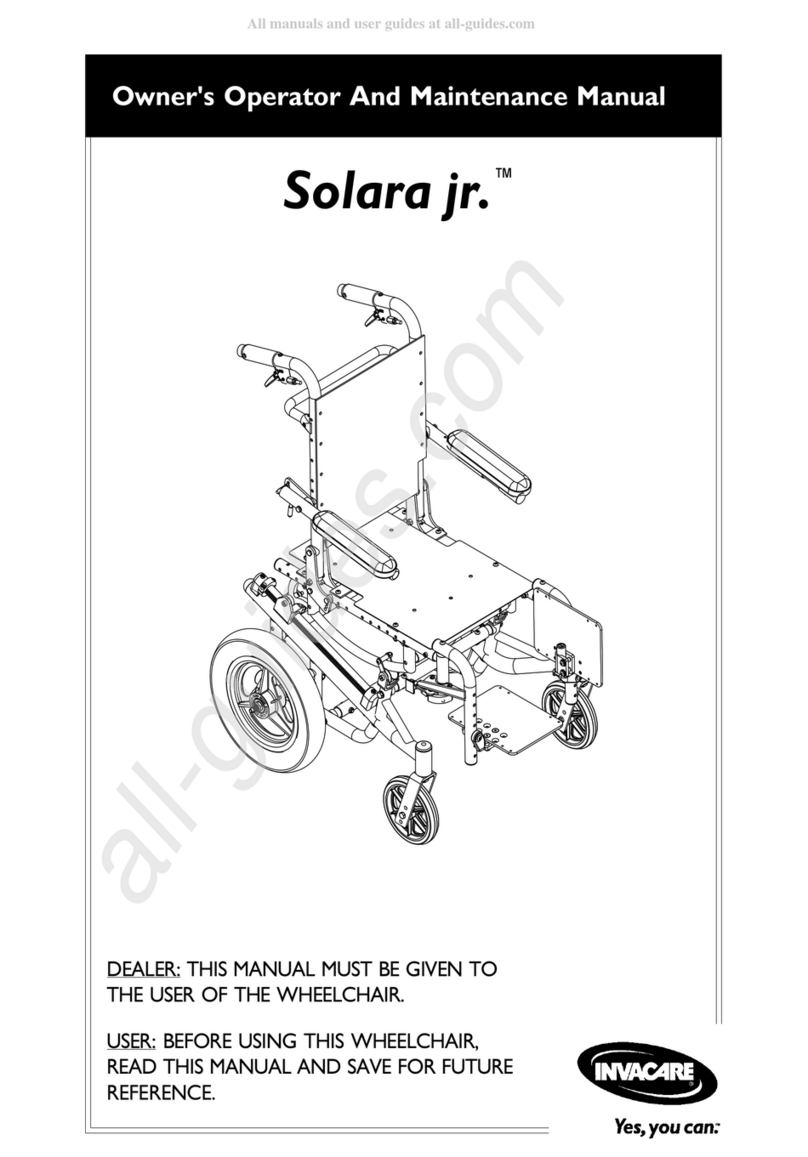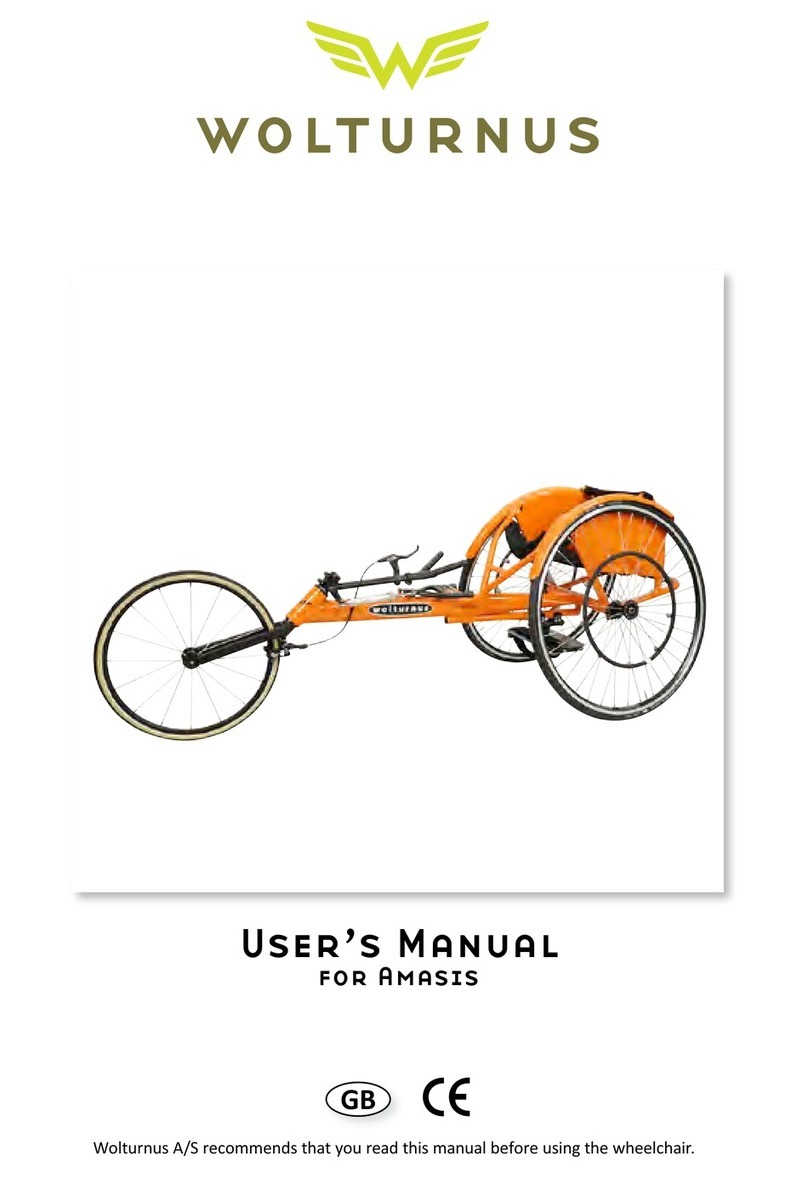Stricker Lipo Lomo Series User manual

Instructions for use
Electric Power Assist Devices
R&E Stricker Reha-Entwicklungen GmbH
V-Nr.: EL EN EC 20210818 1119
Model series
Lipo Lomo
Pico
Crossbike

Manufacturer
R&E Stricker Reha-Entwicklungen GmbH
Klotzberg 64
D-77815 Bühl
Phone: +49 7223 / 72510
Fax: +49 7223 / 74947
E-Mail: [email protected]
Web: www.stricker-handbikes.de
Misprints, mistakes and price or product changes reserved. Product changes include changes resulting from the
further development of the mechanics or the legal requirements.
18.08.2021
© R&E Stricker Reha-Entwicklungen GmbH, Bühl
Reprint, even in part, only with the written permission of R&E Stricker Reha-Entwicklungen GmbH , Bühl.
Notice to reader
For reasons of readability, the masculine form has been chosen in these instructions for use, nonetheless
the information relates to members of all genders.

R&E Stricker Reha-Entwicklungen GmbH
1
Power Assist Devices
Table of Content
1 Declaration of Conformity ..................................................................................................................3
2 Introductory notes..............................................................................................................................3
3 Product Description & Intended Use ...................................................................................................4
4 Safety and driving instructions for accident prevention ......................................................................4
4.1 Safety instructions ......................................................................................................................................4
4.2 Safety checks ..............................................................................................................................................4
4.3 Driving instructions .....................................................................................................................................5
4.4 Safety instructions for battery and charger...............................................................................................6
5 Condition of the wheelchair................................................................................................................7
6 Commissioning ..................................................................................................................................8
7 Fitting the handbike to the wheelchair and the rider............................................................................8
7.1 Unpacking the handbike .............................................................................................................................8
7.2 Adjusting the inclination of the headstock tube........................................................................................9
7.3 Adjusting the length and width of the clamping device............................................................................9
......................................................................9
7.5 Adjusting the ground clearance .............................................................................................................. 11
8 Adjusting the traction device to the wheelchair and the driver (Pico frame) ......................................12
8.1 Assembly of the U-frame......................................................................................................................... 13
8.2 Adjusting the inclination of the coupling plate....................................................................................... 14
8.3 Adjusting the height of the coupling plate.............................................................................................. 15
8.4 Adjusting the handlebar height ............................................................................................................... 15
9 Coupling the handbike to the wheelchair ..........................................................................................15
9.1 Coupling standard frame......................................................................................................................... 15
9.2 Coupling the Pico frame .......................................................................................................................... 16
10 Uncoupling the handbike from the wheelchair ..................................................................................16
10.1 Unhitching Standard Frame..................................................................................................................... 16
10.2 Uncoupling the Pico frame ...................................................................................................................... 16
11 Operation .........................................................................................................................................16
11.1 Model range Lipo Lomo........................................................................................................................... 16
11.2 Crossbike range........................................................................................................................................ 20
12 Steer ................................................................................................................................................24
12.1 Function of the steering damper............................................................................................................. 24
13 Breaks..............................................................................................................................................24
14 Kickstand.........................................................................................................................................24
14.1 Standard equipment................................................................................................................................. 24
14.2 Special equipment quick adjustment ..................................................................................................... 25
15 Battery and charger..........................................................................................................................25
15.1 Charging the battery................................................................................................................................. 25
15.2 Model series Lipo Lomo .......................................................................................................................... 25

2
R&E Stricker Reha-Entwicklungen GmbHPower Assist Devices
16 Repair, cleaning and maintenance ....................................................................................................25
16.1 Cleaning and care..................................................................................................................................... 26
16.2 Air pressure of the drive wheel................................................................................................................ 26
16.3 Clamping device ...................................................................................................................................... 26
16.4 Automatic catch....................................................................................................................................... 26
16.5 V-Brake...................................................................................................................................................... 26
16.6 Disc brake ................................................................................................................................................. 28
17 Transport .........................................................................................................................................29
17.1 Transporting batteries ............................................................................................................................. 29
17.2 Transportation in vehicle ........................................................................................................................ 30
17.3 Airplane transportation............................................................................................................................ 30
18 Reuse...............................................................................................................................................30
19 Disposal and recycling .....................................................................................................................30
20 Materials used .................................................................................................................................30
21 Warranty and guarantee ...................................................................................................................30
22 Liability ............................................................................................................................................31
Attachment ............................................................................................................................................32
A Torque list................................................................................................................................................. 32
B Technical data Lipo Lomo ....................................................................................................................... 32
C Technical data Lipo Lomo Pico............................................................................................................... 32
D Technical data Crossbike ........................................................................................................................ 33

R&E Stricker Reha-Entwicklungen GmbH
3
Power Assist Devices
Declaration of Conformity
1 Declaration of Conformity
The device complies with the current standards and guidelines of the EU. We certify
this in the EC declaration of conformity. If required, we will be happy to send you the
corresponding declaration of conformity. Our power assist devices have been tested by
means of an electromagnetic compatibility test (EMC).
In the event of a change not agreed with R&E Stricker GmbH, this declaration loses its validity.
devices - Stricker Handbikes) comply with the essential requirements according to the new regulation
(EU) 2017/745 (MDR) or the Medical Devices Act. The documentation of the production is available at
the company R&E Stricker Reha-Entwicklungen GmbH. R&E Stricker Reha-Entwicklungen GmbH holds full
responsibility for the issuance of the declaration of conformity.
DECLARATION OF CONFORMITY (CE, MDR)
https://www.stricker-handbikes.de/en/about-us
2 Introductory notes
WARNING
Before operating the handcycle or power assist device, please read these operating instructions and all
other supplied operating instructions carefully and observe them.
WARNING
Visually impaired persons or persons with cognitive impairments must have the information material and
operating instructions read aloud by assistants. Corresponding documents are available on our website
www.stricker-handbikes.de on the Internet. Videos and photos are also available there.
DEALER NOTICE
It is imperative that you hand over these operating instructions to each customer when handing over the
handbike and expressly draw the customer’s attention to the safety and danger instructions.
Never deliver a handbike without operating instructions!

4
R&E Stricker Reha-Entwicklungen GmbHPower Assist Devices
Product Description & Intended Use
3 Product Description &
Intended Use
The handbike is coupled to a manual wheelchair as
a manual traction aid. This allows the driver to be
supported in his mobility. The aim is to extend the
range of action by making it easier to cover longer
distances independently. Coupling the handbike
creates a three-wheeled vehicle with three relatively
large wheels. The handbike therefore improves
driving characteristics on uneven surfaces.
Obstacles can also be overcome more easily.
Driving downhill and on slopes becomes safer due
to the additional braking systems. The handbike
can be independently coupled to and released
from the wheelchair by the rider. The wheelchair as
such is not changed and its properties remain fully
intact.
4 Safety and driving
instructions for accident
prevention
WARNING
These instructions are for your own safety.
Please read them carefully before operating the
hand bike and observe the instructions! Failure
to observe the operating instructions could result
in damage to the product as well as serious
personal injury. We accept no liability for damage
resulting from failure to observe the operating
instructions.
NOTE
Observe all safety and hazard information and
instructions, both in this and in all other operating
instructions supplied.
4.1 Safety instructions
For your own safety, do not go without a bicycle
helmet when riding a handcycle or power assist
device.
4.1.1 Permitted speed
Richten Sie sich unbedingt nach den gesetzlichen
Bestimmungen des Landes, in dem Sie das
Zuggerät betreiben. Das Zuggerät ist für eine
Höchstgeschwindigkeit von 15 km/h zugelassen.
In Deutschland brauchen Sie eine Betriebserlaubnis
und ein Versicherungskennzeichen, wenn
Ohne Betriebserlaubnis gilt 6 km/h als
Höchstgeschwindigkeit. Bei starkem Gefälle darf
nur mit einer deutlich niedrigeren Geschwindigkeit
gefahren werden, um jederzeit sicher Bremsen zu
können.
4.1.2 Permitted payload
The maximum load of the handbike is 120 kg. The
manufacturer may limit this. Use the lower value as
a guide.
4.1.3 Users with small children
In the interest of the child, please refrain from
driving a traction device with a child on your lap.
There is a high risk of injury.
4.2 Safety checks
WARNING
Carry out the following safety checks before every
journey. These are primarily for your safety and
the safety of all other road users.
4.2.1 Air pressure of the drive wheel
Check the air pressure of the handbike and
wheelchair tires. The air pressure of the handbike
tire should be about 3-4 bar, the air pressure of
the wheelchair drive wheels about 5-7 bar. For the
exact maximum values, please refer to the imprint
on the respective tire. Too low an air pressure of
the wheelchair wheels increases the risk of tipping
over, especially in curves!
4.2.2 Secure t of all components
Check all components, especially all screws, for
be checked particularly carefully and tightened if
necessary to exclude twisting. For the exact torque
values, please refer to „Attachment - A Torque list“.
Achten Sie auf einen festen Sitz der Batterien
in den dafür vorgesehenen Halterungen und
schließen Sie die Batterien ab. Dies gilt besonders,
wenn Sie die Batterien zuvor zum Ladevorgang
vom Zuggerät abgenommen haben.
4.2.3 Straight run
Determine whether the drive wheel is aligned
centrally to the wheelchair. The wheel must be in
the center of the wheelchair track. Deviations of no

R&E Stricker Reha-Entwicklungen GmbH
5
Power Assist Devices
Safety and driving instructions for accident prevention
more than 1 cm from the center are permissible. If
necessary, use the instructions from „7.4 Coupling
the handbike to the wheelchair for the rst time“.
The double-acting steering return supports
straight-ahead running. Detailed information or
setting instructions can be found in „12.1 Function
of the steering damper“.
WARNING
An incorrectly aligned drive wheel can lead to
accidents due to poor straight-ahead running and
vibrations.
4.2.4 Braking
Check whether the braking power of your handbike
settings of the brakes
(„16.5 V-Brake“ & „16.6 Disc brake“)
Note that weather conditions, the road surface
and the weight of the handbike and rider have a
Make sure that the parking brakes of your
wheelchair are correctly adjusted. Always secure
your vehicle with the parking brakes against
unintentional rolling away, especially when parking
on sloping surfaces. Avoid parking on sloping
surfaces if possible.
4.3 Driving instructions
4.3.1 Getting used to the handbike
WARNING
Always adjust your driving to the degree of your
disability.
WARNING
Always drive only fast enough to be able to
brake safely at any time, even in unforeseeable
situations! This applies especially to downhill
driving.
WARNING
Always hold the cranks with both hands when
riding and braking to reduce the risk of accidents.
Safe control of the combination of wheelchair and
handbike requires some practice. Cautious and
slow riding is particularly useful for beginners.
Avoid mountainous terrain and bad roads at the
beginning until you have familiarized yourself with
the driving characteristics of the handbike.
By attaching the handbike or power assist device
to your wheelchair, the four-wheeled wheelchair
becomes a tricycle with various advantages
and disadvantages. In curves, a tricycle is
more unstable than a normal wheelchair! In the
beginning, familiarize yourself with the new driving
and tilting behavior by driving carefully. Avoid jerky
steering movements at all costs!
Also slowly get used to the higher speeds that can
be reached with the handbike. Adjust your speed to
4.3.2 Driving at dusk and darkness
Always switch on the built-in lighting for rides at
dusk and in the dark. Attach the supplied rear light
to the back of your wheelchair. Always check the
batteries for the rear light before driving off and
have new ones ready.
4.3.3 Risk of falling
Avoid jerky steering movements at all costs!
Drive at a slow speed, especially in curves and in
unclear situations. Tilt your upper body towards the
inside of the curve (like a cyclist) to avoid tipping
over the wheelchair.
With narrow wheelchairs and little camber of the
wheelchair’s drive wheels, the lateral tipping hazard
is particularly high. To reduce the risk of tipping, we
recommend our track widening Kippex.
To avoid the risk of falling, do not perform the
following maneuvers with the handcycle or power
assist device:
• Driving over several steps or landings
• Driving over a curb at an angle
• Turning on sloping roads
• Quick steering movements
• Abrupt braking in curves
• Braking too hard on wet roads
Reduce your speed when transitioning between
slopes and level terrain.
negative camber of the wheelchair’s rear wheels.

6
R&E Stricker Reha-Entwicklungen GmbHPower Assist Devices
Safety and driving instructions for accident prevention
4.3.4 Mountain rides
If the incline is too steep, the drive wheel can lose
grip and spin. To improve the climbing ability,
you can equip your handbike with a wheelbase
extension and additional weights. These also have
a positive effect on traction on unpaved paths and
braking behavior. Avoid attaching weight (e.g. a
backpack) to the back of the wheelchair. It is better
to use a luggage carrier at the front.
Observe the battery temperature on the display
when driving uphill in extreme conditions. The
temperature must not exceed 45°C. To prevent
overheating, take an operating break to relieve the
batteries.
WARNING
If the drive wheel slips when driving downhill, it
may be necessary to additionally apply the brakes
of the wheelchair.
4.4 Safety instructions for battery
and charger
WARNING
Before carrying out any repair, cleaning or
maintenance tasks on the power assist device,
switch off the electrical components and remove
the batteries from the traction unit.
The batteries supplied are only used to power
the power assist device‘s drive systems. Do not
connect any other systems to the battery. Any use
beyond this requires the written permission of the
at the time of printing. A case of misuse includes,
but is not limited to:
• Use of the battery contrary to the description
and instructions in the user manual.
• Use of the battery in excess of the technical
performance limits
•
•
• Use of the battery to supply other systems
We accept no liability for damage in the event of
misuse.
HEALTH INFORMATION
In case of contact with escaping gases, supply
fresh air. In case of body contact with battery
plenty of water. In case of contact with mucous
membranes or discomfort, consult a doctor.
4.4.1 Operation
Operate the battery only in ambient temperatures
between -20°C and 50°C. Operating outside the
temperature range will shorten the life of the
battery and may cause ignition.
Do not subject the battery to shocks. If the battery
has been dropped or has taken a knock, the battery
must be checked by the manufacturer. Contact
your dealer or the manufacturer for return and
repair/disposal procedures. This also applies to
otherwise damaged or defective batteries. Never
continue to use a damaged or defective battery. Do
not open the battery yourself.
Keep the battery dry and clean. Protect the battery
against the ingress of moisture or foreign particles.
Do not connect the battery‘s contacts to metallic
or other conductive objects. Keep the battery away
from small metallic objects such as screws, coins,
paper clips, keys or similar to avoid a short circuit.
Clean dirty contacts only with a dry, clean cloth. Do
not immerse the battery in water.
If you notice that the battery is overheating, leaking,
smoking, emitting an unusual odour or deforming,
stop using the battery immediately and switch it
off.
(radiators, microwaves, ovens, strong sunlight).
Exposure to heat can cause ignition and explosion.
Do not open the battery casing. Do not
disassemble the battery. Damage to the battery
explosion. Opening the battery will void the
warranty.
FIRE FIGHTING
Do not attempt to extinguish lithium-ion
batteries with water or other liquids in the event
manufacturers as the only extinguishing agent.

R&E Stricker Reha-Entwicklungen GmbH
7
Power Assist Devices
Condition of the wheelchair
Extinguish lead-gel batteries with water, foam or
CO2
involving lead-gel batteries. Do not breathe in the
gases under any circumstances.
4.4.2 Charging process
WARNING
Do not leave the battery unattended during the
charging process.
Charge the battery only at temperatures between
0 and 40°C. Charging outside the temperature
range will be automatically aborted by the battery.
To optimise battery life, charge the battery at
temperatures between 10-30°C.
circulation during the charging process.
substances (solids, liquids, gases).
Protect the battery from moisture during the
charging process. Do not charge the battery in
rooms where water could condense on the battery
or the charger. Only use the charger when it is
completely dry. If condensation has formed, allow
the charger to dry completely before charging.
Only use the charger supplied to charge the
battery. Using any other charger may cause
malfunction, damage, defect, ignition or explosion.
Do not charge the battery with a defective charger.
Replace a defective charger immediately.
Do not use a charger that has been knocked
or dropped. Do not open or repair the charger
yourself.
Do not charge damaged batteries.
Avoid unnecessary charging and do not charge the
battery for a long time when not in use.
The battery charging process is automatically
terminated as soon as the battery is fully charged.
charger from the mains socket and then from the
battery.
Do not carry the charger by the mains cable or the
charging cable. Do not pull on the mains cable to
disconnect the charger from the mains socket. Do
not subject the cables and plugs to pressure or
pinch the parts. There is a risk of electric shock or
ignition.
Position the charger so that no one can step on
or trip over the cable or charger. Also protect the
charger and all related components from other
4.4.3 Storage
Do not store the batteries in places that are
exposed to heat for long periods of time (sunlit
car boot, garden shed, etc.). The service life of
the battery depends, among other things, on the
storage conditions.
Only use your car for transport, not for storing or
keeping the battery.
For optimum service life, store the battery at
18-23 °C and a maximum humidity of 80%. Do not
expose the battery to moisture (rain, snow, etc.)
during storage.
Charge the battery before storage according to
the charge level at least every three months and
recharge the battery if necessary.
Ensure that the battery is stored away from
damage and unauthorised access.
Store the battery out of the reach of children.
5 Condition of the wheelchair
Your handbike can be mounted to different
wheelchairs. For this purpose, your wheelchair
should be in a technically perfect condition. Do not
use a wheelchair that has already undergone major
repairs to the frame. We recommend wheelchairs
with rigid frames, as these offer greater stability
for use with a handbike than folding wheelchairs.
Nevertheless, most folding wheelchairs are
suitable for combination with our handbikes. If you
have any questions about your wheelchair model or
a planned new purchase, please contact us.
Make sure that the brakes of the wheelchair are in
perfect condition.
Despite the attached handbike, you can move the
wheelchair normally by driving the rear wheels.
This means that driving forwards and backwards
is possible without restriction. Steering by moving
the wheelchair wheels is only possible to a limited
extent due to the automatic steering reset.

8
R&E Stricker Reha-Entwicklungen GmbHPower Assist Devices
Commissioning
6 Commissioning
Instruction is provided by a dealer, a medical
or a Stricker employee at R&E Stricker GmbH on
site. We recommend involving an assistant for
instruction and commissioning who can later
provide handling support if necessary.
When using the handcycle or power assist device
yourself with the handcycle. Always adapt the
speed and driving maneuvers to your own ability,
the legal regulations. After a short time you will
get a feeling for the handbike. Before you ride the
handbike on slopes, inclines or uneven terrain,
ground.
7 Fitting the handbike to the
wheelchair and the rider
NOTE
Unpacking and installation video can be found on
www.stricker-handbikes.de/installationsupport
WARNING
Ensure that all screws are tightened to the
appropriate torques after adjustment is complete.
The corresponding torques can be found in
the following instructions and in „Attachment
- A Torque list“. Screws that are not tightened
lead to serious injuries.
Fig. 1: Lipo Lomo
Fig. 2: Standard frame
7.1 Unpacking the handbike
The handbike is tied up in the box for transport. Cut
the cord before removing the handbike.
Zum Transport werden beide Längsrohre nach
oben verdreht. Die Einstellungen der Teile wird im
Folgenden erklärt.

R&E Stricker Reha-Entwicklungen GmbH
9
Power Assist Devices
Fitting the handbike to the wheelchair and the rider
NOTE
To perform all adjustments, place the handcycle
and your wheelchair securely on level, solid
ground. Make sure there is enough space and
light to carefully implement the adjustments.
7.2 Adjusting the inclination of
the headstock tube
WARNING
Make sure that the corner brackets secured by the
S1L and S1R screws do not slip out of the cross
tubes. Do not use the insertion depth of the corner
brackets to adjust the width of the clamping
device.
Loosen the S1L and S1R screws using the Allen
key (SW 6) provided. Turn the longitudinal tubes
to the desired angle to the control bearing tube.
of the crank position, you may have to adjust the
angle again. Lightly tighten the S1L and S1R bolts
(Fig. 2).
After completing all adjustments, tighten the S1L
and S1R screws to a torque of 30 Nm.
NOTE
If you make adjustments to the inclination of the
headset tube while the handbike is coupled to the
wheelchair, also loosen the S3L and S3R screws
to prevent tension in the frame. Tighten them
again afterwards with a torque of 30 Nm.
7.3 Adjusting the length and
width of the clamping device
To adjust the length of the longitudinal tubes and
the angle of the clamps, loosen screws S3L and
S3R. Make sure that the length of the longitudinal
tubes is always set identically on both sides (Fig.
3).
Adjust the angle of the clamps according to the
wheelchair frame at the clamping position. This is
especially important for wheelchairs with V-shaped
frames. Lightly tighten the S3L and S3R screws.
After completing all adjustments, tighten the S3L
and S3R screws to a torque of 30 Nm.
NOTE
If you make adjustments to the length of the
longitudinal tubes while the handbike is coupled
to the wheelchair, also loosen the S2L and S2R
bolts to avoid tension in the frame.
To adjust the width of the clamping device, loosen
the S2L and S2R screws. Adjust the clamping
device to the width of the wheelchair frame. Make
sure to set the same angle to the cross tube on
both sides. Lightly tighten the S2L and S2R screws.
After completing all adjustments, tighten the S2L
and S2R screws to a torque of 30 Nm.
Fig. 3: Setting the default frame
7.4 Coupling the handbike to the
wheelchair for the rst time
Fig. 4: Clamp xed to the wheelchair frame
Fig. 4
to the wheelchair. The position clamps mounted
under the clamps ensure that the clamp always

10
R&E Stricker Reha-Entwicklungen GmbHPower Assist Devices
Fitting the handbike to the wheelchair and the rider
sits at the set height. The position clamps are
included in the delivery and should be attached to
the wheelchair.
If your wheelchair has removable footrests, an
adaptation is necessary, as otherwise no stable
connection can be made between the handbike or
traction device and the wheelchair.
7.4.1 Fitting the stem x (optional)
swivelled to the side and ensures that the clamps
of the handbike or traction device can correctly
transfer the power transmission to the wheelchair
determined with the holes. See Fig. 5.
Fig. 5: The pre-mounting x stabilises the swing-away
footrests and enables a stable clamp connection.
7.4.2 Fitting the general adapter
(optional)
the general adapter can be used. The clamps are
mounted on the rigid part of the wheelchair. The
clamping surface then runs forward and provides
a stable and straight support surface for the
clamp. With the different holes, the adapter can be
adapted to the wheelchair.
Fig. 6: Mounted general adapter if a stable clamp connection
is not possible due to removable footrests.
7.4.3 Wheel alignment
Make sure that the screws S1L and S1R as well as
S3L and S3R are only slightly tightened. A slight
adjustment according to the wheelchair should still
be possible. Make sure that the handbike stands
straight.
Align the wheel of the handbike exactly in the
center of the wheelchair track. A maximum
deviation of 1 cm from the center is permissible.
Use the footrest to check the alignment.
WARNING
An incorrectly aligned drive wheel can lead to
accidents due to poor straight-ahead running and
swinging tendencies.
To simplify the adjustment, you can make a
template. Then drive the wheelchair up to the
template so that the wheels are the same distance
from the line of symmetry. Place the drive wheel of
the handbike exactly on the line of symmetry (Fig.
7).

R&E Stricker Reha-Entwicklungen GmbH
11
Power Assist Devices
Fitting the handbike to the wheelchair and the rider
Fig. 7: Template
A Front wheel
B Symmetry line
C Markings for the wheelchair front wheels
D Wheelchair front wheels
Couple the handbike to the wheelchair. Then follow
the further adjustment instructions to adapt the
handbike exactly to you and your wheelchair.
7.5 Adjusting the ground
clearance
Clamp the handbike to the wheelchair.
WARNING
Leave the front wheels of the wheelchair on the
ground. Make all adjustments only when the
wheelchair is parked. There is a considerable risk
of injury when making adjustments in the driving
position.
Fig. 8: Automatic catch open
Fig. 9: Automatic catch closed
1 Locking slot
2 Flap / Cover
3 Bolt
4 Nut
between the front wheels of the wheelchair and
the ground. The setting is made using the SL Allen
screw in the slotted hole adjustment. Set both
automatic notches in the same way. Open the grid
slot in the automatic latch. Move the Automatic
catch mechanism according to your wishes and
tighten the Allen screw SL with a torque of 30 Nm.
If the adjustment of the elongated holes is not
lock nut. Loosen the lock nut. Turn the adjusting
nut according to your requirements. Retighten the
lock nut after completing the settings.

12
R&E Stricker Reha-Entwicklungen GmbHPower Assist Devices
Adjusting the traction device to the wheelchair and the driver (Pico frame)
frame and a cross bike, you may have to mount
loosen the screw SL with which the automatic latch
is attached in the elongated hole and unscrew
the screw completely. Remove the sleeve and all
washers. Make sure you slide the sleeve and all
washers back onto the appropriate screw in the
correct order. Fig. 9.
Now loosen the lock nut on both Automatic catch
and completely unscrew the eyebolt. Also take the
adjusting nut out of the Automatic catch housing.
Install the sleeve from the eyebolt into the slot in
the housing of the automatic catch. Now mount
the screw SL again with all washers through the
Automatic catch-in housing in the elongated hole.
NOTE
Pay particular attention that the smaller washer
(shim washer) is in direct contact with the sleeve.
Otherwise there is a risk of damage to the parts.
with the screw SL. Therefore you have to bend the
screw SL with a torque of 30 Nm. (Fig. 10).
Fig. 10: Converted Automatic catch
WARNING
When lifting the front wheels into the driving
position, both locking pins must engage
simultaneously. This is absolutely necessary for
proper function.
The length of the latching slot provides a reference
point for the setting. When the handbike is parked,
about 1 cm of this should be visible. The longer the
visible part is in the parked position, the greater the
ground clearance in the driving position.
After adjustments have been completed, check the
ground clearance by lifting the front wheels of the
wheelchair into driving position. We recommend a
ground clearance of approx. 3-4 cm. Carry out the
previously described steps until the adjustment
meets your requirements. The adjustment of the
ground clearance may have an effect on the crank
position. Adjust this again if necessary.
8 Adjusting the traction
device to the wheelchair
and the driver (Pico frame)
Fig. 11: Lipo Lomo Pico
WARNING
Ensure that all bolts are tightened to the
appropriate torques after adjustment is complete.
safety risk and can cause serious injury.

R&E Stricker Reha-Entwicklungen GmbH
13
Power Assist Devices
Adjusting the traction device to the wheelchair and the driver (Pico frame)
Fig. 12: Pico frame
8.1 Assembly of the U-frame
The aim of the assembly steps is to position the
top edge of the coupling plate approx. 42 cm
Fig. 13). Once the U-frame with the
coupling plate is correctly positioned and securely
fastened, the traction device can be coupled
to the wheelchair and also uncoupled from the
wheelchair at any time without any problems and
without tools by the driver.
Fig. 13: Adjusting the Lipo Lomo Pico
To do this, open the clamps on both sides just
enough to slide them over the front frame tubes
of the wheelchair. Only open the clamps as far
as necessary, as if they are opened too far the
clamping nuts could fall out (after approx. 20
turns).
Loosen the screws S2L and S2R so that the width
of the U-frame can be adjusted.
Fig. 14: Loosening S2R and S2L
Adjust the angle of the clamps according to the
wheelchair frame at the clamping position. To
do this, loosen the screws S5L and S5R. This is
especially important for wheelchairs with V-shaped
frames.
WARNING
When loosening and tightening the screws S5L
and S5R, be sure to counteract from the inside
with a 4 mm Allen key and tighten the nut with a
5 mm Allen key. Be careful not to overtighten the
screws (10 Nm).
Fig. 15: Loosening S5R and S5L
Now attach the clamping device to the frame of the
wheelchair using the levers H1L and H1R on the
left and right. Make sure that the clamps are at the
that small adjustments can still be made.

14
R&E Stricker Reha-Entwicklungen GmbHPower Assist Devices
Adjusting the traction device to the wheelchair and the driver (Pico frame)
Now carefully align the U-frame so that it is
symmetrical and centred in front of the wheelchair.
Fig. 16: Correctly adjusted frame
To adjust the distance of the cross tube, you can
move the slide tubes in the clamp. This allows you
to shorten or lengthen the frame by a maximum of
3 cm. To do this, loosen the screws S5L and S5R.
Make sure that the slide tubes are in the same
position on both sides to prevent the cross tube
from slipping. Under no circumstances pull the
slide pipes too far out of the clamp. The end caps
must remain completely in front of the clamp.
NOTE
If you need a greater distance from the traction
device to the wheelchair, frames with longer push
tubes are available.
Fig. 17: Adjusting the Pico frame
Check the U-frame carefully for an exact,
symmetrical and centred position in front of the
frame of the wheelchair. Then all screws and
levers loosened so far can be tightened securely to
ensure absolute form stability. Tighten all screws
accordingly: „Attachment - A Torque list“.
If you have carried out all steps one after the
other according to the instructions, the U-frame
is basically ready for use. If necessary, however,
adjustments of the coupling plate must be carried
out before the traction unit can be coupled. To do
this, please carry out the necessary steps below.
8.2 Adjusting the inclination of
the coupling plate
You can adjust the ground clearance of the
front wheels of the wheelchair by adjusting the
inclination of the coupling plate. Loosen the screws
S1L and S1R. Now you can change the inclination
of the coupling plate by turning the cross tube.
After you have adjusted the inclination according to
your wishes, carefully tighten all screws according
to the torque list: „Attachment - A Torque list“.
Fig. 18: Coupling plate tilted too much
Fig. 19: Correctly inclined coupling plate

R&E Stricker Reha-Entwicklungen GmbH
15
Power Assist Devices
Coupling the handbike to the wheelchair
8.3 Adjusting the height of the
coupling plate
(Abb. 17) Loosen the screws S4L and S4R. Now
you can adjust the height of the coupling plate
by tilting the U-frame up or down. After you have
adjusted the height according to your wishes,
tighten all screws carefully according to the torque
list: „Attachment - A Torque list“.
Fig. 20: Loosening S4R and S4L
8.4 Adjusting the handlebar
height
Loosen the lever HS and adjust the height of the
handlebars according to your wishes. For transport,
it is a good idea to push the handlebars together
completely. (Fig. 24).
9 Coupling the handbike to
the wheelchair
9.1 Coupling standard frame
Once you have carefully adjusted the handbike to
your wheelchair, you can easily and quickly connect
and disconnect it from your wheelchair at any time.
If locked, unlock the Automatic catch. To do this,
(Fig. 8 und Fig. 9
spring open and release the locking pin. Now you
can adjust the clamping device and thus relax
the automatic detents to maximum length. We
recommend that you close the detents again
immediately to avoid injury when operating the
clamping levers.
Open the clamping device on both sides just
enough so that they can be slid over the front
frame tubes of the wheelchair. Open the clamps
only as far as necessary, as opening them too far
could cause the clamping nuts to fall out (after
approx. 20 turns).
WARNING
Tighten the ball handle nut or the tetrastar nut
with a maximum torque of 6-8 Nm!
Grasp the handbike by the handlebar and attach
it to the front frame of the wheelchair using the
clamping device. Now tighten the clamps on both
sides.
For your own safety, we recommend locking the
brakes on the wheelchair and handbike for the
coupling process. This will prevent the handbike
or wheelchair from moving and you will have both
hands free to close the clamps..
To further simplify the coupling process, you
will receive positioning clamps together with the
handbike, which you can permanently mount on the
wheelchair. You can easily and safely position the
handbike’s clamping device on these and only have
to close the clamps.
NOTE
When closing the clamps, always make sure that
the clamps are aligned parallel to the tubes of
the front frame of the wheelchair. If this is not the
case, there is a risk of damage to the PVC caps.
Before coupling, make sure that the PVC caps
are undamaged. Damaged PVC caps can cause
damage to the wheelchair.
WARRANTY & LIABILITY NOTICE
The PVC caps are wearing parts, therefore no
warranty applies to them. We accept no liability
for damage caused by damaged PVC caps.
Now release the brakes of the handbike. Push the
handbike forward by the handlebar so that the front
wheels of the wheelchair lift off the ground. Push
the handbike forward until the automatic locks
engage on both sides. You should hear a distinct
click. Check whether both locking pins are visibly
engaged.

16
R&E Stricker Reha-Entwicklungen GmbHPower Assist Devices
Uncoupling the handbike from the wheelchair
9.2 Coupling the Pico frame
As soon as the U-frame and the coupling plate
have been brought into the optimal position, you
can couple the traction device to the wheelchair.
Check the position of the rotary switch D1. This
must point downwards before the docking process
so that the pin controlled by it protrudes. (Fig. 12).
Position the towing device centrally in front of the
coupling plate and lift the lateral pins of the towing
device into the slots provided in the coupling plate.
in and must then automatically pop out again as
soon as the towing device is in the correct position.
Now push the handlebar of the towing device away
from you and thereby carefully lift the front wheels
of the wheelchair until the lower pins of the towing
device engage in the coupling plate. Make sure that
the pins are engaged on both sides. The towing
device is now ready to drive.
10 Uncoupling the handbike
from the wheelchair
10.1Unhitching Standard Frame
If locked, unlock the Automatic catch. To do this,
(Fig. 8 und Fig. 9
on the locking bolt. The release only works as
long as the indexing bolt is unloaded. To release
the indexing plunger, grasp the handbike by the
handlebar and push it forward away from your
bolt back and unlock the automatic locking
mechanism. Now carefully set down the front
wheels of the wheelchair. We recommend closing
when operating the clamping levers.
WARNING
As soon as you press the handbike forward by the
handlebar with the louvers open, the automatic
louvers unlock. You now hold the full weight.
force the detent bolts back. This could bend the
the function of the automatic detent.
Once you have parked the handcycle or power
assist, you can open the clamps and release
the handcycle from the wheelchair. Only open
the clamps as far as necessary, since if they are
opened too far, the clamping nuts could fall out
(after approx. 20 turns).
10.2Uncoupling the Pico frame
To uncouple the towing device from the wheelchair,
push lever H2 all the way forward. This unlocks
the pins at the bottom of the coupling plate and
the traction unit detaches from the coupling
plate, thereby lowering the raised wheels of the
wheelchair to the ground.
Now turn the rotary switch D1 upwards so that the
pin controlled by it is lowered. The traction device
is now completely detached from the U-frame. Lift
the traction device slightly out of the coupling plate
and place it on the stand.
NOTE
Turn the rotary switch back down immediately
after uncoupling so that you do not forget to do
so the next time you couple it.
11 Operation
11.1Model range Lipo Lomo
1 Key switch
2 Three-position switch
3 Light
4 Capacity indicator
5 Rotary throttle
6 Brake lever with break contact
7 Bell
8 Reverse gear (extra equipment)
9 Cruise control (extra equipment)
10 Speedometer
11 USB socket (extra equipment)
HS Handlebar height adjustment
HL Handlebar screw
H2 Coupling plate release

R&E Stricker Reha-Entwicklungen GmbH
17
Power Assist Devices
Operation
Fig. 21: Lipo Lomo control unit
Fig. 22: Lipo Lomo Pico control unit
Fig. 23: Lipo Lomo handlebar
Fig. 24: Lipo Lomo Pico handlebar
11.1.1 Start driving
WARNING
When parking the traction unit, always remove the
key for the key switch to prevent unauthorised use
of the unit.
Fig. 25: Battery

18
R&E Stricker Reha-Entwicklungen GmbHPower Assist Devices
Operation
Switch on the battery with the main switch on the
battery. You will know that the battery is switched
on when the lamp on the battery lights up (Fig. 25).
Turn the key switch with the key to the „ON“
position (Fig. 21 bzw. Fig. 22). Remove the key and
stow it safely so as not to lose it while driving.
Turn the right handle to accelerate.
The brake lever on the right side of the handlebar
automatically interrupts the drive electronics when
actuated. You therefore cannot operate the right
brake lever and accelerate at the same time.
The brake lever on the left side of the handlebar
has no breaker contact. You can use the left brake
lever for starting uphill.
11.1.2 Starting uphill
If you have stopped on an incline and want to start
again, you may roll backwards and not be able to
start. In order to be able to start despite the slope,
lean forward to put more weight on the front wheel.
Press and hold the left brake lever. At the same
time, carefully apply the accelerator. Reduce the
pressure on the brake while slowly increasing the
throttle. As soon as you feel that you are moving
in the direction of travel, you can release the brake
completely.
11.1.3 End of ride
Switch off the battery using the main switch on the
battery. You will know that the battery is off when
the light on the battery is not lit. (Fig. 25).
Turn the key switch on the control unit with the
key to the „OFF“ position. (Fig. 21 bzw. Fig. 22).
Remove the key and store it in a safe place. Make
sure it is not within reach of unauthorised persons
or children.
11.1.4 Optional extras: lights/horn and
cruise control/reverse gear.
Fig. 26: Left: Light (red) and horn (green); Right: reverse gear
(red) and cruise control (green).
To switch on the light on the traction unit, press the
red button with the light symbol on the left handle.
Press the button again to switch the light off. Press
the green button with the horn symbol to activate
the horn.
To activate reverse gear, press the red button
on the right handle. Press the button again to
disengage reverse gear. Press the green button
to activate the cruise control. When the cruise
control is activated, it saves and maintains your
current driving speed. Press the button again to
deactivate cruise control. Pressing the brake with
breaker contact (brake on the right handle) also
deactivates the cruise control. Should you use the
throttle handle while the cruise control is active,
the traction unit will not accelerate. If the throttle
grip is turned back to the zero position after
accelerating, this will deactivate the cruise control.
WARNING
permits. Be ready to deactivate cruise control at
any time with the brake with breaker contact.
11.1.5 Optional equipment: 2 Lipo
batteries with 2 change-over
switches
With this optional equipment for the Lipo Lomo you
get a towing device with two batteries on the fork
and a control box with two toggle switches. The
standard battery holder on top is omitted with this
equipment.
This manual suits for next models
2
Table of contents
Popular Wheelchair manuals by other brands
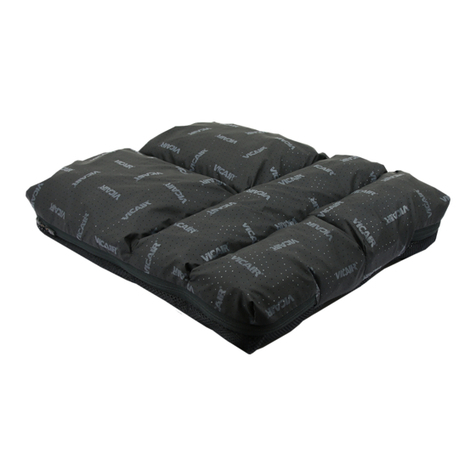
Vicair
Vicair VECTOR O2 Important notice

Drive Medical
Drive Medical Travelite Chair In A Bag Owner's handbook

Pressalit
Pressalit PLUS shower seat 450 Operation and maintenance manual
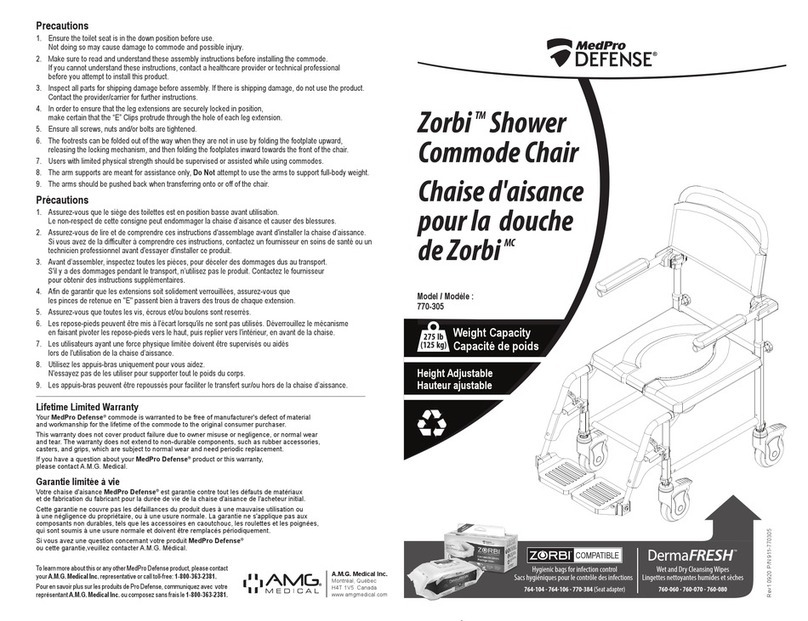
AMG Medical
AMG Medical MedPro DEFENSE Zorbi 770-305 Assembly instructions

Vermeiren
Vermeiren Forest 3 installation manual

DiscountRamps
DiscountRamps Silver Spring ESC400 instructions


